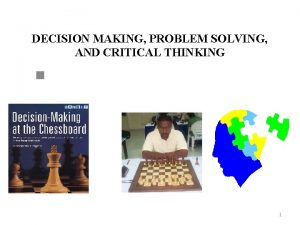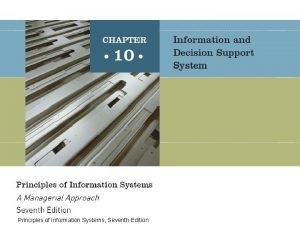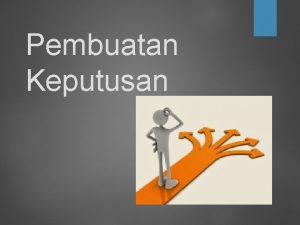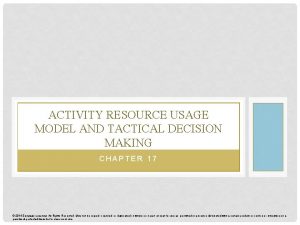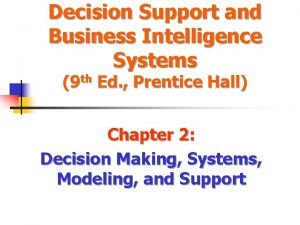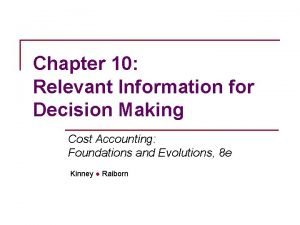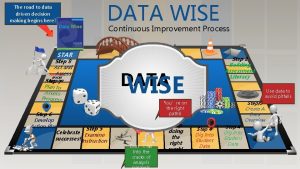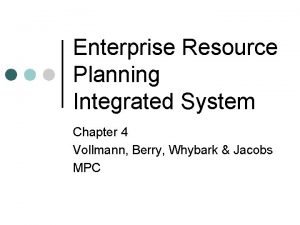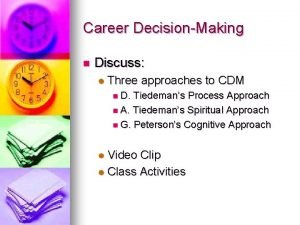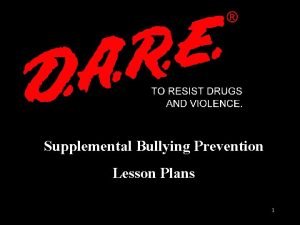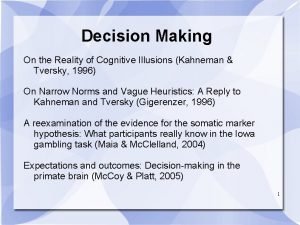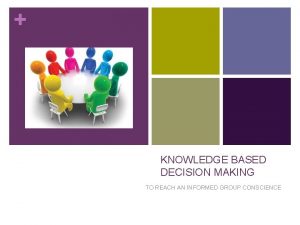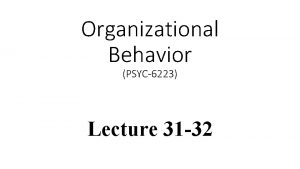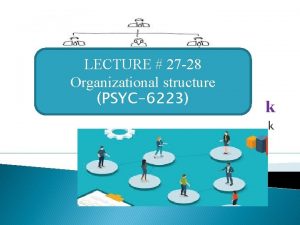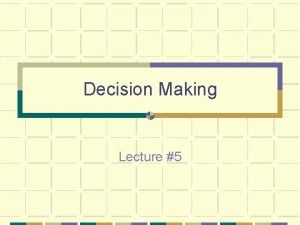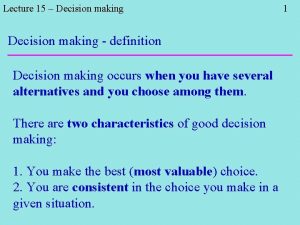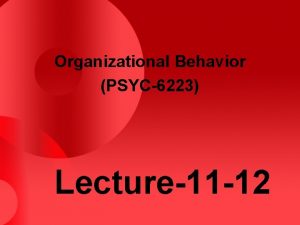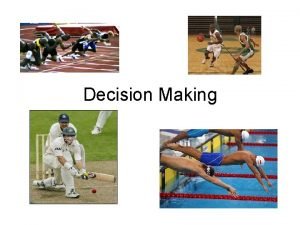LECTURE 17 18 Decision Making in Groups PSYC6223
































- Slides: 32

LECTURE # 17 -18 Decision Making in Groups (PSYC-6223)


What is Decision-Making? �Decision making is the process whereby a final best choice is made among the alternatives available. �Group decision making (also known as collaborative decision making) is situation faced when individual s collectively make a choice from the alternative before them. The decision is no longer attributable to any single individual who is member of the group.

Types Of decision Making Consensus Mode �When all members of the group agree to the decision arrived at , it is called ‘consensus’. Majority Vote If majority of the group members agree to the decision arrived at , is called ‘majority vote’.

Group decision making process 1. Diagnose the problem 2. Developing alternatives 3. Evaluating the alternatives 4. Implementation and monitoring the task

Process (cont…) Diagnose the problem : � To identify the problems to be solved Developing Alternatives : �Through different sources like experience , practice in other groups, and ideas and suggestions from different parties involved Evaluating the alternative : �To know their plus and minus points, and then the most appropriate alternative is selected

Cont…. Implementation and monitoring the decision �Implementation of selected alternatives, Checking with reference to the expectations, and making requires corrections, if any.

How do groups make decisions? Group size Not too large , nor to small. The ideal size is 5 to 7 members for effective decision making. Group Composition Higher status of some group members, in terms of background or expertise, influences the other group , members opinion. Unanimity of Group Consensus A united group exerts greater pressure to conform than a group divided by dissension.

Cont… �The Risky Shift People tend to make more risky decision as a group rather than as an individual.

Advantages of group decision making � Compared to an individual, the groups generally have a greater knowledge, expertise and skill base to make better decision. �Large number of members provide more perspectives of the problem. �With large number of group members, the participation also increases that helps reach quality decision. Following increased participation, comprehension of final decision arrived at is usually high.

Disadvantages… �It is a time consuming process. � Influencing members usually manipulate the group decision in a direction of their interest and liking. �Sometimes decision made the group members are simply a compromise between the various views and options offered by the group members.

Characteristics of group decision making. . �Mental and intellectual process…. �It is a Process…. �It is an indicator of commitment…. �It is a Best Selected Alternative…. �Decision-Making Might be Positive or Negative… �It is the Last Process…. �Decision Making is a Pervasive Function…. �Continuous and Dynamic Process….

How to facilitate team decision making? �Break down the problem… �Analyze the available data… �Brainstorm possible situations… �The team leader should navigate the group discussion… �Settle on a solution and action steps for moving forward…

What is group aided decision making? Group aided decision making: �The group does everything except make the decision. Group decision making: � The group actually makes final decision collectively.

Groupthink �Have you ever been in a decision making that you group was heading in wrong direction but you didn’t speak up and say so? If so you have already been a victim of groupthink. Group think is a tendency to avoid negative evaluation of ideas an favors. �Irving Janis, author of group called Victims of Groupthink, explained groupthink is characterized by eight symptoms.

Symptoms of groupthink �Illusion of invulnerability is shared by most or all the group members , which create excessive optimism and encourage them to take extreme risks. �Collective rationalization occur, in which members downplay negative information or warnings that might cause them to reconsider their assumptions. �An unquestioned belief in the groups inherent mortality occurs, which may incline members to ignore ethical or moral consequences of their actions.

Cont. . � Stereotyped views of out groups are seen when groups discount rivals abilities to make effective responses. � Direct pressure is exerted on any members who express strong arguments against any of the groups stereotypes, illusions or commitment. � Self censorship occurs when members of the group minimize their own doubts and counterarguments. � Illusions of unanimity occur , based on self censorship and direct pressure on the group. � The emergence of self appointed minguards happen when one or more members protect the group from information that runs counter to the group’s assumptions and course of action.

Recommendations for avoiding groupthink Groups should do the following: �Discuss the symptoms of groups and how to avoid them. �Assign a rotating devil’s advocate to every meeting. �Invite experts and qualified colleagues and get reactions from outsiders on regular basis and share with group. �Encourage a culture of difference where differenr ideas are valued. �Debate the ethical implications of the decision and potential solutions being considered.

For individuals. . �Individuals should do the following: �Monitor personal behavior for signs of groupthink and modify behavior if needed. �Check for self censorship. �Carefully avoid mind guard behaviors. �Avoid putting pressure on other group members to conform. �Remind members of the ground rules for avoiding groupthink if they get off track.

For group leaders Group leaders should do the following: �Break the group into two subgroups from time to time. �Have more than one group work on the same problem is time and resources allow it. This makes sense for highly critical decisions. �Remain impartial and refrain from stating preferences at the outset of decisions. �Set a tone of encouraging critical evaluations throughout deliberations. �Create anonymous feedback channel through which all members can contribute if desired.

Techniques of group decision making Brain Storming 2. Nominal Group Technique 3. Delphi Technique 4. Consensus Mapping 1.

Brainstorming. . �Originally adopted by Alex Osborn 1938 in an American Company. �According to him, brainstorming means using the brain to storm the problem. �Four basic guidelines: 1. Generate as many ideas as possible. 2. Be creative , freewheeling and imaginative. 3. Build upon piggybank, extend or combine earlier ideas. 4. Withhold criticism of others ideas.

Cont. . �Two underlying principles: 1. 2. � � � Differed judgment , by which all ideas are encouraged without criticism. Quantity breeds quality. Advantages: Useful for simple and well-defined problems Stimulates creativity

Nominal Group techniques � A nominal group exist in name only , and the members have minimal interaction prior to making decisions. � Process: 1. Members brought together and presented the problem. 2. Each members develops solution/ideas independently and writes them on cards. 3. All present their ideas in round robin procedure. 4. Brief time is allotted to clarify ideas after the presentation by all. 5. Group members individually rank their preferences for the best alternatives by secret ballot. 6. Group decision is announced based on this ranking.

Cont… Advantages: 1. Less time consuming. 2. Influence of dominant group members over others is minimized. 3. Integration of both group creativity and individual creativity. 4. Equal participation. Disadvantages: � Members do not have equal opportunity to benefit from cross fertilization of ideas.

Delphi Technique �“Delphi” is a place, where the ancient Greeks used to pray for information about future. �In this technique members, selected are experts, and scattered over large distances, having no face to face interaction for decision making. �The effectiveness of the technique depends on the adequate time, participants expertise, communication skills, and motivation of the members.

Cont… Process: 1. The problem is identified and a set of questions are built relating to a problem. 2. Experts in the problem are identified and contacted, to whom the questionnaire is sent. They independently answers the questions and send it back to the central coordinator. 3. These responses are compiled analyzed and on their basis, a second questionnaire is developed, which is mailed back to the participating members to comment, suggest and answer the question and generate new ideas. 4. The responses to this second questionnaire compiled and if a consensus has not been reached, then a third questionnaire is developed and the above procedure is repeated until a consensus is obtained. Then final decision is taken.

Cont… �Advantages: Elimination of interpersonal problems among members. 2. Efficient use of the experts time. 3. Adequate time for reflection and analysis by respondents. Disadvantages: 1. Complexity 2. High cost involved 3. Time -consuming 1.

Consensus Mapping � Here , an attempt is made to arrive at a decision by pooling the ideas together generated by several task subgroups. Process: 1. It begins with developing ideas by a task subgroup. 2. The facilitators encourage participants to further develop clusters of ideas. 3. The ideas so generated are developed and narrowed in a smaller number of ideas. 4. They are consolidated into a representative structure called “straw man map "Which is further narrowed down to arrive at a mutually acceptable solution.

Pitfalls/ Barriers to effective group decision making � Procrastination: Replacing high priority tasks with low priority. � Bolstering: Reinforcing a decision by exaggerating its favorable consequences and minimizing importance of unfavorable consequences. � Denying responsibility: No individual can be held accountable for the results. � Sins of commission: The misuse or inappropriate use of information. � Sins of omission: The overlooking of useful information. � Sins of imprecision: Relying too heavily on heuristics, which over simplify complex decisions.

ANY QUESTIONS?

� THANK YOU
 Objectives of decision making
Objectives of decision making Slidetodoc.com
Slidetodoc.com 01:640:244 lecture notes - lecture 15: plat, idah, farad
01:640:244 lecture notes - lecture 15: plat, idah, farad How are ethnic groups and religious groups related
How are ethnic groups and religious groups related Decision theory lecture notes
Decision theory lecture notes Bayesian decision theory lecture notes
Bayesian decision theory lecture notes Making small groups work
Making small groups work Decision tree and decision table examples
Decision tree and decision table examples Traditional problem solving process nursing
Traditional problem solving process nursing Principles of decision making
Principles of decision making Intuitive decision making
Intuitive decision making Habitual decision making adalah
Habitual decision making adalah Activity resource usage model and tactical decision making
Activity resource usage model and tactical decision making Decision making in programming
Decision making in programming Systematic decision making process
Systematic decision making process List 20 personal decision
List 20 personal decision Relevant information for decision making
Relevant information for decision making Using functions in models and decision making
Using functions in models and decision making Lung cancer screening shared decision making tool
Lung cancer screening shared decision making tool Decision making in healthcare
Decision making in healthcare Decision making begins with
Decision making begins with Relevant information for decision making
Relevant information for decision making Routine decision making
Routine decision making Three approaches of decision making
Three approaches of decision making Management chapter 5 planning and decision making
Management chapter 5 planning and decision making What is the dare decision making model
What is the dare decision making model Cognitive illusions in decision making
Cognitive illusions in decision making Knowledge based decision making
Knowledge based decision making Long term decision making
Long term decision making Decision making meaning
Decision making meaning Decision making exercise
Decision making exercise Higher business corporate culture
Higher business corporate culture Unstructured decision
Unstructured decision








